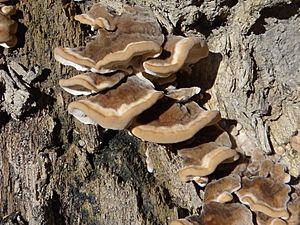Bjerkandera fumosa facts for kids
Quick facts for kids Bjerkandera fumosa |
|
|---|---|
 |
|
| Scientific classification | |
| Kingdom: | |
| Division: | |
| Class: | |
| Order: |
Polyporales
|
| Family: |
Meruliaceae
|
| Genus: |
Bjerkandera
|
| Species: |
B. fumosa
|
| Binomial name | |
| Bjerkandera fumosa (Pers.) P.Karst. (1879)
|
|
| Synonyms | |
|
|
Bjerkandera fumosa is a type of polypore fungus. It belongs to the family Meruliaceae. This fungus is known for its unique shape and how it grows on wood.
What's in a Name?
This fungus was first described in 1801 by a scientist named Christiaan Hendrik Persoon. He called it Boletus fumosus. Later, in 1879, another scientist named Petter Adolf Karsten moved it to a different group, the genus Bjerkandera. That's how it got its current name, Bjerkandera fumosa.
What Does It Look Like?
The Bjerkandera fumosa fungus can grow in different ways. Sometimes it spreads out flat on wood and then curls up at the edges to form a cap. Other times, it grows directly as a cap attached to the wood, without a stem.
- These caps can grow alone or close together, often joining with other caps nearby.
- They usually measure about 5 to 10 centimeters (2 to 4 inches) wide.
- The top surface of the cap is often a light brown or "buff" color. It can feel a bit hairy or completely smooth.
- If you look underneath the cap, you'll see tiny holes called pores. These pores are usually round or slightly angled. There are about 2 to 5 pores in every millimeter.
Inside the fungus, it has special threads called hyphae. These threads help the fungus grow. It also has tiny structures called basidia that help it make spores. The spores are very small, shaped like short cylinders, and are smooth and clear.
Where Does It Live?
Bjerkandera fumosa is a type of wood-decay fungus. This means it causes a "white rot" in different kinds of hardwood trees. White rot breaks down parts of the wood, making it soft and spongy.
You can find this fungus in many places around the world. It grows in the Northern Hemisphere, which includes areas like North America, Europe, and Asia.
See also
 In Spanish: Bjerkandera fumosa para niños
In Spanish: Bjerkandera fumosa para niños

